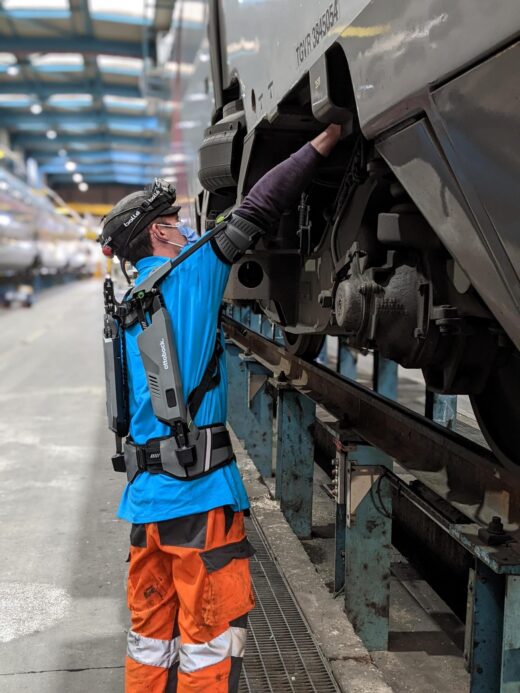How can workplaces be made healthier, safer, more productive and more attractive? Exoskeletons can be used to reduce physical strain on employees and prevent injuries. Innovations for ergonomic workplaces will be presented at the Hannover Messe.

Exoskeletons provide support as a natural extension of the body during strenuous activities.
Photo: Ottobock
Back pain! Lumbago! Who of us doesn't know it? In many jobs, back pain is an almost occupational occurrence. In the workplace, many jobs involve significant physical strain. Whether it's heavy physical labor on the production floor or long hours at a desk, the effects on physical health can be severe.
Some of us have to perform a certain movement over and over again, which can lead to wear and tear and injury. Back, shoulder, neck... all of these can lead to long-term staff absences or even permanent damage to health.
How can you reduce physical stress on the job?
There are various ways to reduce physical stress at work. Companies can, for example, provide ergonomic workstations to improve workers' posture, introduce certain movement breaks and motivate their employees to take part in them. Many companies use ergonomic aids, such as special mouse pads or keyboards, to reduce strain.
Advancing automation could counteract the problem, but not solve it completely. According to medical technology company Ottobock, automation cannot solve all labor shortage problems. "There are areas that cannot be automated only with disproportionate effort," David Duwe, who is responsible for the exoskeleton division, told dpa. Technical aids can also come into play here.
Engineers are in charge
The idea is to support workers in their work with so-called exoskeletons. These are not medical walking aids, such as those used for paraplegics, but preventive measures in the workplace to proactively avoid musculoskeletal disorders and injuries, Duwe explained.
Ingenieur.de also asked what the situation is like for engineers. "Even if engineers themselves have less physically demanding jobs, they still have a responsibility to implement their projects ergonomically. For example, in the fields of electrical engineering, mechanical engineering, energy technology or transportation, engineers deal with colleagues who work overweight or handle heavy loads on a daily basis. Exoskeletons are an effective tool here for preventing musculoskeletal disorders such as back pain," explained David Duwe, Vice President Ottobock Bionic Exoskeletons Europe, in response to our inquiry, pointing out that exoskeletons themselves are also a result of outstanding engineering.
What is meant by exoskeletons?
Exoskeletons are wearable robotic suits that can assist or augment human movements. They are increasingly used in the workplace to reduce physical strain on workers, increase their efficiency and prevent injuries. They can be used in many industries, such as manufacturing, logistics, nursing and even mining.
In the manufacturing industry, exoskeletons are used to assist workers with heavy and repetitive tasks such as lifting, screwing and welding. This can reduce the load on joints and muscles, and the worker is not exhausted as quickly. In the logistics industry, exoskeletons can assist in loading pallets, significantly reducing the strain on workers' muscles and joints.

Exoskeletons are also used for train maintenance.
Photo: Ottobock
In use in logistics, retail, automotive and aviation
Ottobock will present innovations for ergonomic workplaces at the Hanover Fair - with the goal of making workplaces healthier, safer, more productive and more attractive. In doing so, the company points to the increasing shortage of skilled workers. Industries such as logistics, retail, automotive and aviation are under pressure. The situation is made even more difficult by absences from work due to illness. "In logistics, for example, there are 25 days of absence per year for every employee in Germany due to sickness-related incapacity to work. A large proportion of these are due to musculoskeletal disorders (MSDs), such as back problems caused by lifting and carrying loads. MSDs cause €17.2 billion in lost production or €30.5 billion in lost gross value added per year in Germany alone," the press release states.
Solutions for the whole body
"The current transformation of the working world in the sense of 'New Work' does not stop at so-called blue-collar employees. Colleagues in production, trade or commerce also want more scope for shaping their work. The use of exoskeletons, on a voluntary basis, can be a real milestone in this regard. The assistance systems are literally a support for hard-working people while still being very comfortable," explains Martin Böhm, Chief Experience Officer at Ottobock. In addition, there are solutions that support the entire body (e.g., back, shoulder, neck, wrist or thumb).
For example, one model can be used to relieve employees in logistics, employees who move loads manually and at the same time need to be flexible. The exoskeleton can reduce the load on the lower back when lifting objects by an average of 60 percent.
Support for strenuous over-shoulder activities
The other model is suitable for people who carry out strenuous over-shoulder activities. For example, in automobile manufacturing, train repair or aircraft construction. They are used, for example, by Airbus, Deutsche Bahn and Toyota North America. France's state-owned railroad company SNCF also uses the exoskeleton to make maintenance of its TGV trains more efficient, among other things, according to the Ottobock press release.
"We see our exoskeletons as a natural extension of the body," said David Duwe. "They work on a biomechanical principle by redirecting and temporarily storing forces in the body. This technology is called 'energy harvesting.' Without the use of batteries at all, our exoskeletons are particularly lightweight and can be put on and taken off in under 30 seconds."
Source: How can exoskeletons combat skills shortages? - engineer.com
